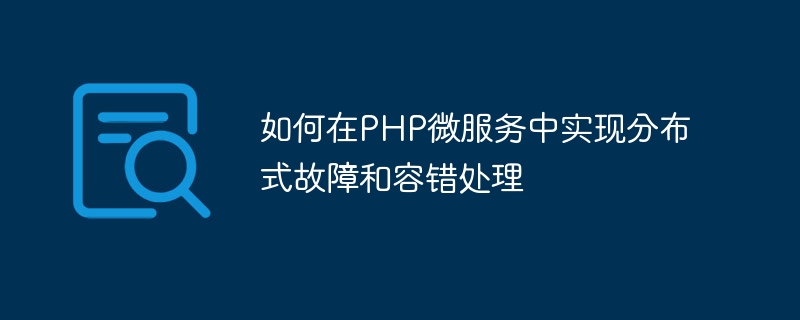Home >Backend Development >PHP Tutorial >How to implement distributed fault and fault tolerance in PHP microservices
How to implement distributed fault and fault tolerance in PHP microservices
- WBOYWBOYWBOYWBOYWBOYWBOYWBOYWBOYWBOYWBOYWBOYWBOYWBOriginal
- 2023-09-28 08:02:061361browse

How to implement distributed fault and fault tolerance processing in PHP microservices
In modern distributed systems, faults and fault tolerance are inevitable issues. Especially in a microservice architecture, each service is relatively independent, and communication between them is carried out through the network, which makes the system more complex and more prone to failure. In order to ensure the stability and reliability of the system, we need to implement distributed fault and fault tolerance processing in PHP microservices. This article will introduce some common methods and provide specific code examples.
- Retry mechanism
The retry mechanism is a common fault-tolerant processing method. When a microservice request fails, we can choose to resend the request in the hope that the next request will succeed. In PHP, we can use the try-catch statement to implement the retry mechanism. The following is a simple code example:
function sendRequest($url) {
$maxRetries = 3;
$retryInterval = 1000; // 1 second
for ($i = 0; $i < $maxRetries; $i++) {
try {
$response = file_get_contents($url);
return $response;
} catch (Exception $e) {
echo "Request failed. Retrying in $retryInterval milliseconds...";
usleep($retryInterval * 1000);
}
}
throw new Exception("Failed after $maxRetries retries");
}
$url = "http://example.com/api";
$response = sendRequest($url);
echo $response;In the above code, we use a for loop to retry up to 3 times. If the request cannot be sent successfully within the number of retries, we will throw an exception.
- Current limiting mechanism
Since communication between services is conducted through the network, in high concurrency scenarios, if a certain microservice is overloaded or fails, it may cause the entire system to fail. Performance degrades. In order to deal with such a situation, we can use a current limiting mechanism to control the access rate of the service. In PHP, we can use mutexes or semaphores to implement the current limiting mechanism. The following is a simple code example:
function sendRequest($url) {
$rateLimit = 10; // 10 requests per second
if (acquireLock()) {
$response = file_get_contents($url);
releaseLock();
return $response;
} else {
throw new Exception("Rate limit exceeded");
}
}
function acquireLock() {
$lockFile = "/tmp/lock";
$timeout = 1000; // 1 second
$fp = fopen($lockFile, "w");
if (flock($fp, LOCK_EX | LOCK_NB)) {
return true;
} else {
usleep($timeout * 1000);
return false;
}
}
function releaseLock() {
$lockFile = "/tmp/lock";
$fp = fopen($lockFile, "w");
flock($fp, LOCK_UN);
fclose($fp);
}
$url = "http://example.com/api";
$response = sendRequest($url);
echo $response;In the above code, we use a file lock to implement the current limiting mechanism. If the lock file is already occupied by another process, wait for a while and try again. If the lock cannot be obtained, an exception is thrown.
- Service downgrade
Service downgrade refers to temporarily switching to a backup mechanism or reducing service quality in the face of a failure to ensure system availability. In PHP microservices, we can achieve service degradation by using caching, using backup services, or returning to default values. Here is a simple code example:
function sendRequest($url) {
$fallbackUrl = "http://backup.com/api";
$cacheKey = "api_response";
$cacheLifetime = 60; // 1 minute
$response = getFromCache($cacheKey);
if (!$response) {
try {
$response = file_get_contents($url);
setInCache($cacheKey, $response, $cacheLifetime);
} catch (Exception $e) {
$response = file_get_contents($fallbackUrl);
}
}
return $response;
}
function getFromCache($key) {
// implementation of cache read method
// return false if cache miss
}
function setInCache($key, $value, $lifetime) {
// implementation of cache write method
}
$url = "http://example.com/api";
$response = sendRequest($url);
echo $response;In the above code, we first try to get the response from the cache. If it does not exist in the cache, the request is sent and the response is saved in the cache. If the sending request fails, the response from the backup service is returned.
Summary:
Implementing distributed fault and fault tolerance processing in PHP microservices is an important measure to ensure system stability and reliability. This article introduces some common methods, including retry mechanism, current limiting mechanism and service degradation. By properly applying these methods, we can improve the fault tolerance of the system and reduce the risk of failure. However, it should be noted that these methods are only part of fault response and fault tolerance processing. We also need to comprehensively consider factors such as system architecture design, performance optimization, and monitoring to build a stable and reliable distributed system.
The above is the detailed content of How to implement distributed fault and fault tolerance in PHP microservices. For more information, please follow other related articles on the PHP Chinese website!

